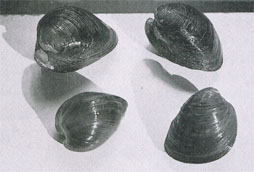|
Species
A number of clam species belonging to the families Arcidae, Veneridae, Corbiculidae,
Tridacnidae, Solenidae, Mesodesmatidae, Tellinidae and Donacidae are exploited along
the Indian coast. The cultivable species belongs to the first four of the above-mentioned
families.
Arcid clams are called blood clams, represented by a single species, Anadara granosa.
It occurs all along the Indian coast in soft muddy substratum. Venerid clams are
most sought after in the clam fisheries of India and three genera namely Meretrix,
Paphia and Katelysia are important. Along the Kerala coast P. malabarica
forms a fishery in Koduvally, Azhikkal, Karyamgod and Chittari estuaries
and Ashtamudi lake. Other Venerid clams form fisheries in several estuaries of Kerala
state.
The black clam Villorita cyprinoides is a major resource in the Vembanad
lake and is also exploited in several backwaters, lakes and estuaries of Kerala.
The family Tridacnidae is represented in India by Tridacna maxima, T. crocea, T.
squamosa and Hippopus hippopus. They are called as giant clams
and occur in the Andamans.
|

Anadara granosa
|

Katelysia spp.
|
|

Villorita cyprinoides
|

Meretrix spp.
|

Paphia spp.
|

Tridacna squamosa
|
Exploitation
Clams are fished by men, women and children all along the Indian coast. They are
collected from the intertidal region to about 4 m depth. They are handpicked and
also a hand-operated dredge is used. Plank-built non-powered boats are used for
transport. Clams under one year age contribute in considerable numbers to the fishery.
V. cyprinoides is the mainstay of the clam fisheries accounting for 64%,
followed by the Venerid clams at 31%. West coast accounts for 85.7% of the estimated
annual production of about 45,500 t of clams. Kerala ranks top with 72.5% of the
production followed by Karnataka, which accounts for 12.5%.

Canoe with the clams
Seed collection
In clam culture, seed collected from the natural grounds and those produced in the
hatcheries are used. The clam seed are collected from the natural beds one month
after the onset of spawning by sieving the sediment.
Top
|